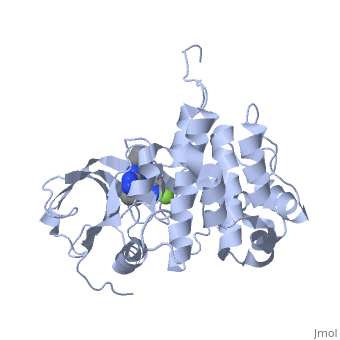Insulin-like growth factor receptor: Difference between revisions
Michal Harel (talk | contribs) No edit summary |
Michal Harel (talk | contribs) No edit summary |
||
| Line 1: | Line 1: | ||
<StructureSection load='3i81' size='350' side='right' scene='' caption='Human insulin-like growth factor 1 receptor complex with inhibitor (PDB code [[3i81]])'> | <StructureSection load='3i81' size='350' side='right' scene='' caption='Human insulin-like growth factor 1 receptor complex with inhibitor (PDB code [[3i81]])'> | ||
'''Insulin-like growth factor receptors''' (IGFR) are transmembrane receptors which are stimulated by insulin-like growth factors (IGF). IGFR contains 2 extracellular α chains and 2 transmembranal β chains. Upon binding of IGF, a tyrosine in the β chain becomes autophosphorylated and triggers a cascade of intracellular signaling. The insulin-like growth factor 1 (IGF-1) receptor belongs to the large class of [[Receptor tyrosine kinases|tyrosine kinase receptors]]. See also [[IGF1]] | '''Insulin-like growth factor receptors''' (IGFR) are transmembrane receptors which are stimulated by insulin-like growth factors (IGF). IGFR contains 2 extracellular α chains and 2 transmembranal β chains. Upon binding of IGF, a tyrosine in the β chain becomes autophosphorylated and triggers a cascade of intracellular signaling. The insulin-like growth factor 1 (IGF-1) receptor belongs to the large class of [[Receptor tyrosine kinases|tyrosine kinase receptors]]. See also [[IGF1]], [[Growth factors]]and [[Kinase-linked, enzyme-linked and related receptors]]. | ||
. | |||
=== Memory-Enhancement by Traditional Chinese Medicine? <ref>doi 10.1080/07391102.2012.741052</ref>=== | === Memory-Enhancement by Traditional Chinese Medicine? <ref>doi 10.1080/07391102.2012.741052</ref>=== | ||
Revision as of 12:47, 19 January 2022
Insulin-like growth factor receptors (IGFR) are transmembrane receptors which are stimulated by insulin-like growth factors (IGF). IGFR contains 2 extracellular α chains and 2 transmembranal β chains. Upon binding of IGF, a tyrosine in the β chain becomes autophosphorylated and triggers a cascade of intracellular signaling. The insulin-like growth factor 1 (IGF-1) receptor belongs to the large class of tyrosine kinase receptors. See also IGF1, Growth factorsand Kinase-linked, enzyme-linked and related receptors. . Memory-Enhancement by Traditional Chinese Medicine? [1]Cognitive impairment is an emerging issue and increasing research points to the significant role of insulin-like growth factor I (IGF-I) in cognitive brain functions. (IGF-IR, PDB ID: 3i81, colored in darkmagenta) activation is critical for IGF-I to elicit desirable cognitive functions. Traditional Chinese medicine (TCM) ligands (orgin: Isatisin digotica, colored in green), (origin: Lindera aggregate, colored in deeppink), and (origin: Nelumbonucifera Gaertn, colored in salmon) showed high binding affinity towards IGF-IR at the binding site defined by the control in PDB ID: 3i81. Molecular dynamics simulation revealed that the TCM ligands were secured at the opening of the IGF-IR binding site for the duration of the MD. was stabilized by , was stabilized by , and was stabilized by (key residues are colored in yellow). Four different quantitative-structure activity relationship models consistently predicted bioactivity of the TCM ligands towards IGF-IR. In summary, the TCM candidates exhibit drug-like potential in both structural-based and ligand-based properties and may have potential for further applications in enhancing cognition. |
| ||||||||||
3D structures of insulin-like growth factor receptor3D structures of insulin-like growth factor receptor
Updated on 19-January-2022
ReferencesReferences
- ↑ Hung IC, Chang SS, Chang PC, Lee CC, Chen CY. Memory enhancement by traditional Chinese medicine? J Biomol Struct Dyn. 2012 Dec 19. PMID:23249175 doi:10.1080/07391102.2012.741052
